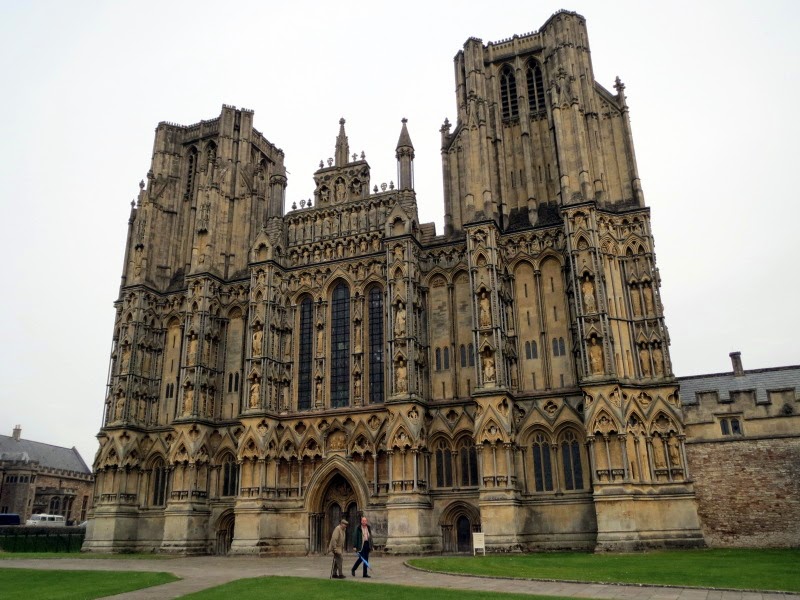A couple of Sundays back we were in
Wells, Somerset - England's smallest city - as Clare had been shortlisted in a writing competition. Unfortunately she wasn't placed, but it turned out to be a pleasant day out, as I hadn't been to Wells since I was about 7.
It's surprisingly easy to get to from Exeter, even on a Sunday: about an hour's train journey to Bristol Temple Meads, then a bus from the end of the station approach road. This is also takes a bit under an hour, and after climbing up through the slightly seedy south side of Bristol, the route crosses farmland on the undulating limestone plateau of the Mendips.
Wells is very worth seeing, the cathedral complex in particular; this includes the cathedral itself, its close, and the associated Bishop's Palace. It brings home the sheer wealth that the area commanded in mediaeval times. It's also generally a well-equipped town centre, and a bonus was finding a food festival on the Market Square at the head of the town: Thai curry never disappoints.
Click any image to enlarge ![]() |
| Wells, Market Square |
![]() |
| Wells, Market Square |
![]() |
| Gateway toward Bishop's Palace |
Externally, the Cathedral is almost menacing in its blockiness and complexity of stonework.
![]() |
| Cathedral - west face |
I had a look inside - they don't officially charge, and the requested donation is reasonable - but unfortunately it was in the middle of Evensong, and there was only access to the nave. So I didn't see the famous
astronomical clock or the
prettier architecture such as the Chapter House and Lady Chapel, which was described in Alec Clifton-Taylor's 1967
The Cathedrals of England as "one of the most subtle and entrancing architectural prospects in Europe". I did, however, get to see the 'giant angry owl' arches at the base of the central tower.
While undoubtedly striking, and unique to British cathedrals, they're not just some inspired architectural conceit. As with many cathedrals (I've already mentioned the scary internal bracing of
Salisbury Cathedral) they exist to remedy a structural problem. The owls are actually 'strainer arches' (aka
scissor arches) inserted as an elegant load-bearing solution after the central piers of the
crossing began sagging in the 14th century.
![]() |
| Cathedral from the Bishop's Palace - that central tower is what the 'owls' help support |
![]() |
Picture in Crown Hotel, Market Square, Wells
Nick Frost, Simon Pegg, and director Edgar Wright |
By coincidence, the 2006 action comedy
Hot Fuzz was on ITV2 on Tuesday, and it's generally well-known that this spoof of the "buddy cop" genre was filmed largely in Wells, as the fictional "Sandford, Gloucestershire". For instance, Market Square is the scene of the final shoot-out; and the Bishop's Palace is where Simon Pegg's policeman protagonist goes to confront the conspiracy. The cathedral was digitally removed from shots, as the focus of many events, such as a lethal fete, was the impressive
St Cuthbert's Church. See
The Hot Fuzz Film Tour location map for more details.
![]() |
| Entrance to the moated Bishop's Palace |
Although the allusions in
Hot Fuzz are largely to action cop movies - the joke being to bring the genre to a small rural town - but there are also definite Wells motifs. One of the favourite fixtures of Wells is the
Bishop's Swans in the moat, which in a reversal of Pavlovian conditioning are trained to ring a bell when they want feeding. A rogue swan is a recurring motif in
Hot Fuzz. And the director
Edgar Wright being brought up in Wells, you do wonder if the film is also saying something about Wells and towns like it. Once you get past the police action movie jokes,
Hot Fuzz - with its Neighbourhood Watch Alliance that will kill to maintain Sandford's niceness - is also a savage satire on the domination of community agendas by middle-aged middle-class elites, in any number of small English rural towns.
![]() |
| A giant false swan in the Bishop's Palace moat |
- Ray













